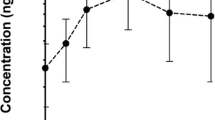Abstract
PTC299 is a novel, orally-bioavailable small molecule that selectively inhibits vascular endothelial growth factor receptor protein synthesis at the post-transcriptional level. Based on promising preclinical results, we conducted a pediatric phase I study to estimate the maximum tolerated dose, describe dose-limiting toxicities (DLT) and characterize the pharmacokinetic profile of PTC299 in children with recurrent CNS tumors. PTC299 was administered orally twice or three times daily, depending on the regimen. Four regimens were evaluated using the rolling 6 design, starting with 1.2 mg/kg/dose twice daily and escalating to 2 mg/kg/dose three times daily. Pharmacokinetic studies were performed during the first two courses. Twenty-seven children (14 male, median age 11.2, range 5.5–21 years) with recurrent brain tumors were treated; 21 were fully evaluable for toxicity assessment. Therapy was well-tolerated, and the only DLT was grade 3 hyponatremia. Grade three and grade four toxicities were uncommon in subsequent cycles. Median AUC0–Tlast values at the 2 mg/kg were similar to those observed in adults. The study was terminated while patients were being treated at the highest planned dose, due to hepatotoxicity encountered in the ongoing adult phase I studies. No complete or partial responses were observed. Two patients with low-grade gliomas were noted to have minor responses, and at the time of the study’s closure, 5 children with low-grade gliomas had been on therapy for 8 or more courses (range 8–16). PTC299 was well-tolerated at the highest dose level tested (2 mg/kg/dose TID) in children with recurrent brain tumors and prolonged disease stabilization was seen in children with low-grade gliomas.



Similar content being viewed by others
References
Folkman J (2007) Angiogenesis: an organizing principle for drug discovery? Nat Rev Drug Discov 6(4):243–286
Pietsch T et al (1997) Expression and distribution of vascular endothelial growth factor protein in human brain tumors. Acta Neuropathol (Berl) 93(2):109–117
Vredenburgh JJ, Desjardins A, Herndon JE 2nd et al (2007) Phase II trial of bevacizumab and irinotecan in recurrent malignant glioma. Clin Cancer Res 13(4):1253–1259
Gururamgam S, Chi SN, Young Poussaint T et al (2010) Lack of efficacy of bevacizumab plus irinotecan in children with recurrent malignant glioma and diffuse brainstem glioma: a pediatric brain tumor consortium study. J Clin Onocol 28(18):3069–3075
Ziche M, Donnini S, Morbidelli L (2004) Development of new drugs in angiogenesis. Curr Drug Targets 5:485–493
Cohen MH, Shen YL, Leegan P, Pazdur R (2009) FDA drug approval summary: bevacizumab (Avastin) as treatment of recurrent glioblastoma multiforme. Oncologist 14(11):1131–1138
Packer RJ, Jakacki R, Horn M et al (2009) Objective response of multiply recurrent low-grade gliomas to bevacizumab and irinotecan. Pediatr Blood Cancer 52(7):791–795
Machein MR, Plate KH (2000) VEGF in brain tumors. Neurooncol 50(1–2):109–120
Levy AP, Levy NS, Goldberg MA (1996) Post-transcriptional regulation of vascular endothelial growth factor by hypoxia. J Biol Chem 271(5):2746–2753
Levy AP (1998) Hypoxic regulation of VEGF mRNA stability by RNA-binding proteins. Trens Cardiovasc Med 8(6):246–250
Akri G, Nahari D, Finkelstein Y, Le SY, Elroy-Stein O, Levi BZ (1998) Regulation of vascular endothelial growth factor (VEGF) expression is mediated by internal initiation of translation and alternative initiation of transcription. Oncogene 17(2):227–236
Huez I, Creancier L, Audiger S, Gensac MC, Prats AC, Prats H (1998) Two independent internal ribosome entry sites are involved in translation initiation of vascular endothelial growth factor mRNA. Mol Cell Biol 18(11):6178–6190
PTC 299 Investiagor Brochure, PTC Therapeutics, Inc. Ver 6, 12, 2 July 2011
Onar-Thomas A, Xiong Z (2010) A simulation based comparison of the traditional method, rolling-6 design and a frequentist version of the continual reassessment method with special attention to trial duration in pediatric phase I oncology trials. Contemp Clin Trials 31(3):259–270
Chenevert TL, Ross BD (2009) Diffusion imaging for therapy response assessment of brain tumor. Neuroimag Clin N Am 19:559
Gururangan S, Fangusaro J, Young-Poussaint T, Lesh S, Onar A, Gilbertson R, Packer R, McLendon R, Friedman HS, Boyett H, LE Kun (2011) Efficacy of bevacizumab +CPT-11 in children with recurrent low-grade glioma (LGG)- a pediatric brain tumor consortium study. Neuro-Oncol 13:iii95–iii101
Hwang E, Jakacki R, Fisher M, Kilburn L, Horn M, Vezina G, Rood B, Packer RJ (2012) Long-term efficacy and toxicity of bevacizumab-based therapy in children with recurrent low-grade gliomas. Pediatr Blood Cancer 60(5):776–782. doi:10.1002/pbc.24297
Poussaint TY, Kocak M, Vajapeyam S, Packer RI, Robertson RL, Geyer R, Haas-Kogan D, Pollack IF, Vezina G, Zimmerman R, Cha S, Patay Z, Boyett JM, Kun LE (2011) MRI as a central component of clinical trials analysis in brainstem glioma: a report from the pediatric brain tumor consortium (PBTC). Neuro-Oncol 13:417–427
Acknowledgments
Supported in part by National Institutes of Health (NIH) Grant No. U01.CA81457 for the Pediatric Brain Tumor Consortium, and the American Lebanese Syrian Associated Charities.
Conflict of interest
Dr. Packer and the co-authors have no direct conflicts of interest.
Author information
Authors and Affiliations
Corresponding author
Rights and permissions
About this article
Cite this article
Packer, R.J., Rood, B.R., Turner, D.C. et al. Phase I and pharmacokinetic trial of PTC299 in pediatric patients with refractory or recurrent central nervous system tumors: a PBTC study. J Neurooncol 121, 217–224 (2015). https://doi.org/10.1007/s11060-014-1665-1
Received:
Accepted:
Published:
Issue Date:
DOI: https://doi.org/10.1007/s11060-014-1665-1




